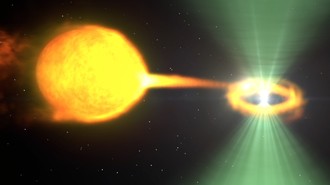
In a paper recently published in Physical Review Letters, Are gravitational waves spinning down pulsar J1023+0038?and higlighted by the editors as Editor's Suggestion, Dr Brynmor Haskell, from the Nicolaus Copernicus Astornomical Center, PAN, and Dr Alessandro Patruno from the University of Leiden, have suggested that the enigmatic spin-down behaviour of one of the so called 'transitional pulsars' may be evidence for the emission of continuous gravitational waves.
Transitional pulsars are neutron stars that alternate between states in which they accrete matter from a companion and are visible as X-ray pulsars, and quiescent states in which accretion ceases and they are visible as radio pulsars.Precise timing of the transitional pulsar J1023+0038 in both the X-ray and Radio phases reveals that the neutron star is spinning down due to the emission of electromagnetic waves, as expected, but is slowing down nearly 30% faster in the X-ray state. This is contrary to the predictions of standard accretion theory, and may be thesignature of gravitational wave emission. In the paper Haskell and Patruno argue that theoretical models for 'mountains', built by the accreted material on the neutron star crust, predict a large enough deformation to explain the behaviour.
A 'mountain' on a neutron star, although less than a millimetre high, will in fact perturb the gravitational field significantly and produce gravitational waves. The gravitational waves remove energy from the star an slow it down. Crucially, the mountain will only appear as matter is accreted, leading to an increase in spin-down rate only in the X-ray phase, as observed. Future X-ray and Radio observations of this system will be able to confirm this scenario, and, while the gravitational waves from J1023+0038 are probably too weak for current gravitational wave searches, it will be a target for future detectors, and the limits set will allow us to select neutron stars to target with current instruments.
Continuous gravitational waves may, in fact, be a much more widespread phenomenon and could explain why to date we have not detected any fast neutron stars spinning with periods of less than a millisecond, which according to standard models should exist.
Picture: NASA Goddard (artist's impression of a transitional pulsar)
Text: Brynmor Haskell, Copernicus Astronomical Center, Warsaw






